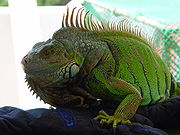When people talk about getting an iguana pet, they usually have in mind to the most common species, the Iguana Iguana or the green iguana.
It is a completely different situation for a green iguana to live in captivity than its natural environment. The most important advantage of raising a green iguana in captivity is that it keeps it far from predators. Even if it has become a popular pet nowadays this does not mean that it is easy to look after this kind of pet.
Here are some tips you will need to consider before having an iguana pet.
First of all, you will need to provide a large space for your green iguana. Given the fact that a green iguana may grow as large as seven feet, the pets habitat should be any owners top priority.
A small space can easily lead to sickness and even vulnerability to infections. The green iguana needs to be able to move around an climb, so make sure the space is large enough for the animal to do all these activities.
Another important thing you need to consider when deciding that a green iguana is the perfect pet for you and your family is the heating device. A green iguana needs to be warm enough in order to digest properly and be healthy. The source of UV light should provide a temperature lower that 26C, but at least one part should have a temperature as high as 35C. In order to reach this purpose, a spotlight would be perfect.
Even if heating and light are important, be sure that darkness is an important aspect too. Approximately 6 to 10 hours of darkness each night should be enough for your green iguana well-being.
Every pet need care and attentions from its owner, so make sure your will be able to watch over your Iguana pet. If you do not give your green iguana enough love and affection, it can get seriously depressed and eventually die.
These were just a few tips that need to be considered in taking care of a green iguana. However, it is better to consult a qualified veterinarian if you want your iguana to live a happy long life.






